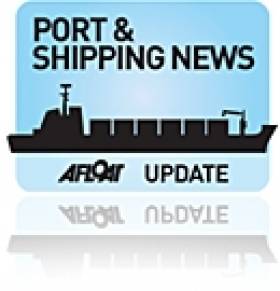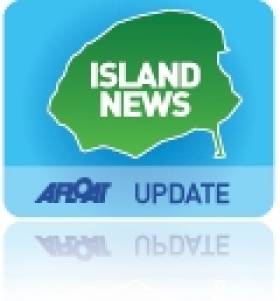Displaying items by tag: Bád Arann Teoranta
Mauritius-Bound Ferries Finally Bid Galway Farewell
First to be loaded was the Clann na nOileáin on Wednesday in an operation than took four-hours while on Friday her sister Clann Eagle I took six-hours to be winched safely onto the cargo-deck during freshening winds.
It is ironic that since Thor Gitta 's arrival to the port's Dún Aengus Dock on 5 April that it would also nearly be the same time taken for the estimated 25-day delivery voyage of the ferries to the Indian Ocean island.
During the 8,300 mile journey Thor Gitta will make several port of calls with the first call to La Rochelle. The Bay of Biscay port is the next largest port south of Les Sables d'Olonnes, where the fast-ferries where built at the OCEA boatyard for her original owners Bád Arann Teoranta which traded as Aran Direct on routes from Rossaveal to the islands.
Thor Gitta was built in 1996 and is also designed to carry 364 TEU (twenty-foot equivilant unit) containers and belongs to an-eight strong fleet operated by the Danish company, Thor Rederi A/S of Svendborg.
One of the reasons why the heavylift vessel was delayed in loading was to ensure the correct positioning of the ferries so not to further disrupt other port call cargo allocation while on the long repositioning voyage to Mauritius.
The 4,078 tonnes cargsoship is also scheduled to make en-route calls to Pointe Noir in the Congo, Cape Town and Pemba in Mozambique before finally reaching the southern Indian Ocean destination.
When the ferries were completed in 2005 and 2006 they were valued between €5-6m but they only served up to September 2008 when the 243 passenger aluminium built craft were laid-up at the Connemara harbour due to financial difficulities.
This led to the company going into receivership and the vessels were put up for auction in Galway last February. Despite bids reaching €950,000, they were withdrawn at the auction hosted by the Cork based auctioneer, Dominic J. Daly.
In the following month the fast-ferries were sold to the French owner for a new career based from the island state which is in the Mascarene Islands. Mauritius is neighboured by the smaller islands of Agalega, Cargados Carajos, Rodrigues and the French island of Réunion some 200km to the southwest.
Good Friday in Galway as Second Ferry is Loaded
Despite freshening winds the 169 gross registered tonnes ferry was winched out of the waters of the port's Dún Aengus Dock. In total the operation took six-hours which saw the delicate positioning of the 27m long ferry between the ship's two deck-mounted cranes and lowered onto the cargo-deck.
Yesterday proceedings to load the ferry were suspended due to delays in relocating other cargo so to accommodate the 243 passenger capacity ferry. This followed the loading of her sister Clann na nOileáin on Wednesday.
Several previous attempts to hoist the Clann Eagle I onto the deck of the Danish-flagged vessel have been hampered. At one stage due to complications in efforts to transport the vessels, the 100m Thor Gitta was temporary detained by the admiralty marshal.
Procedures to load the 29 knots fast-ferry pair have been beset with incidents notably the grounding and subsequent damage to the first chartered cargoship, Patanal, off Rossaveal. It was originally planned to sail the ferries out into Casla Bay where the German-flagged vessel would load them onboard.
As a consequence the ferries were transferred to Galway where the Clann na nOileáin did not escape attention either. On the first attempt to load the ferry one of the ship's slings snapped from the crane-cradle causing the 172 tonnes ferry to fall into the water.
Minor damage was caused to the ferry, though three men who remained onboard at the time of the incident were taken to hospital but were later released.
Last month the ferries were sold to a French buyer after the company that owned them Bád Arann Teoranta (trading as Aran Direct) went into receivership. The ferries operated on several routes between Rossaveal to the islands but are now destined to serve on an inter-island service from the Indian Ocean island.
Auction of Aran Islands Passenger Ferry Sisters
Aran Direct (which was the trading name for Bád Arann Teoranta) operated on routes between Rossaveal to Inis Mór, Inis Meáin and Inis Oírr. The company competed in an intensely competitive market with at least 10 other vessels combined from the fleets of Aran Doolin Ferries, Aran Island Ferries and the Doolin Ferry Company.
In September 2008, Aran Direct ceased operations and the vessels were laid-up at Rossaveal, where they remain, as seen (if not previously sold) prior to the public auction.
At the instructions of Liam Dowdall Esq., Receiver & Manager, Bád Arann Teoranta (in receivership), the vessels are to be sold in one or separate lots. The public auction is to be held at 12 noon on Thursday 24th February at the Harbour Hotel, The Docks, Galway.
An outline of the vessels details can be downloaded in PDF format by clicking HERE. For further details, photographs and conditions of sale contact Dominic J. Daly, Auctioneer, Cork Tel: (021) 4277399 or E-mail: [email protected] and logging on to www.dominicjdaly.com
For further technical details, you can contact Noel O'Regan of Promara Ltd on 087 3435666 or email [email protected]


























































